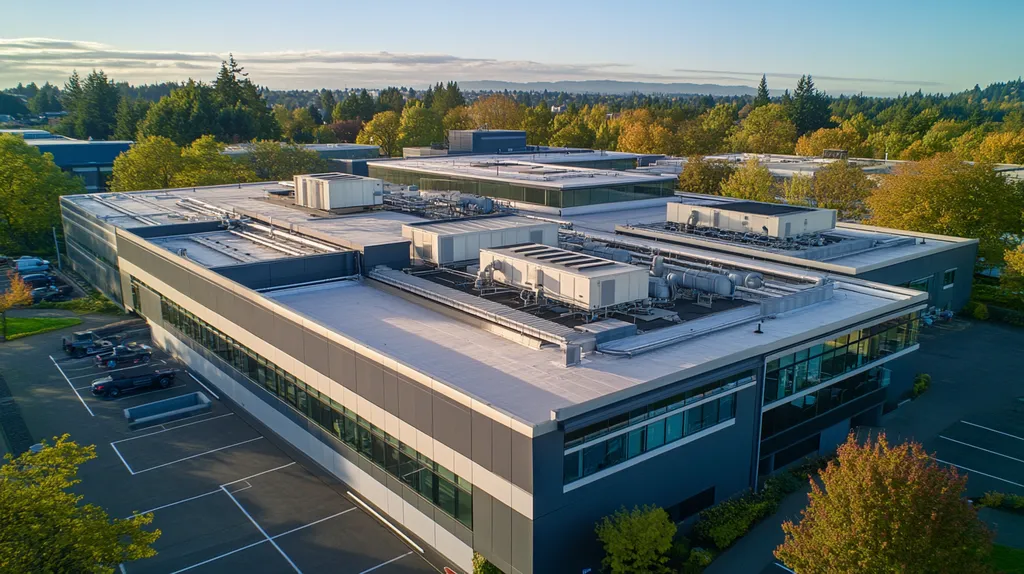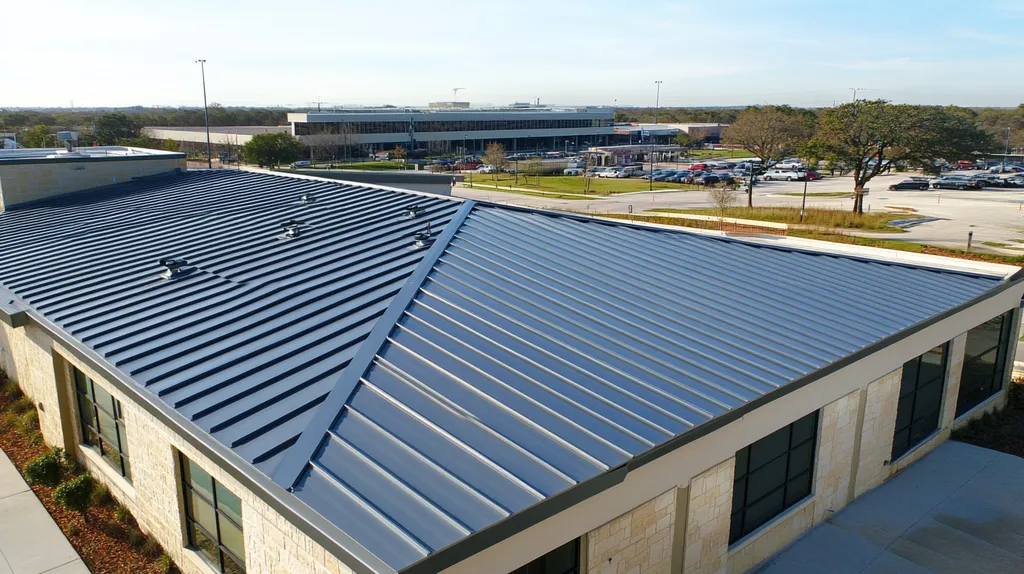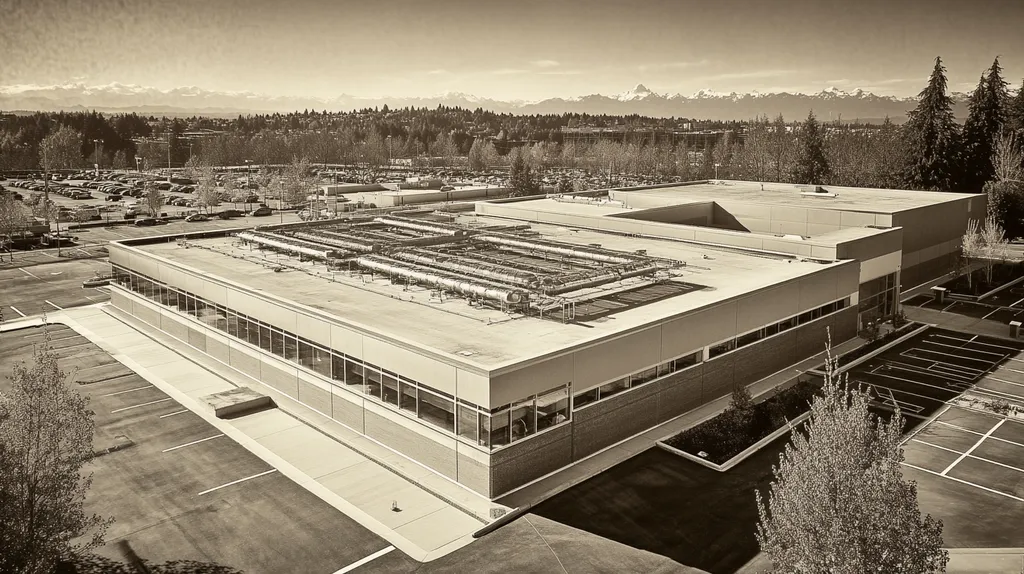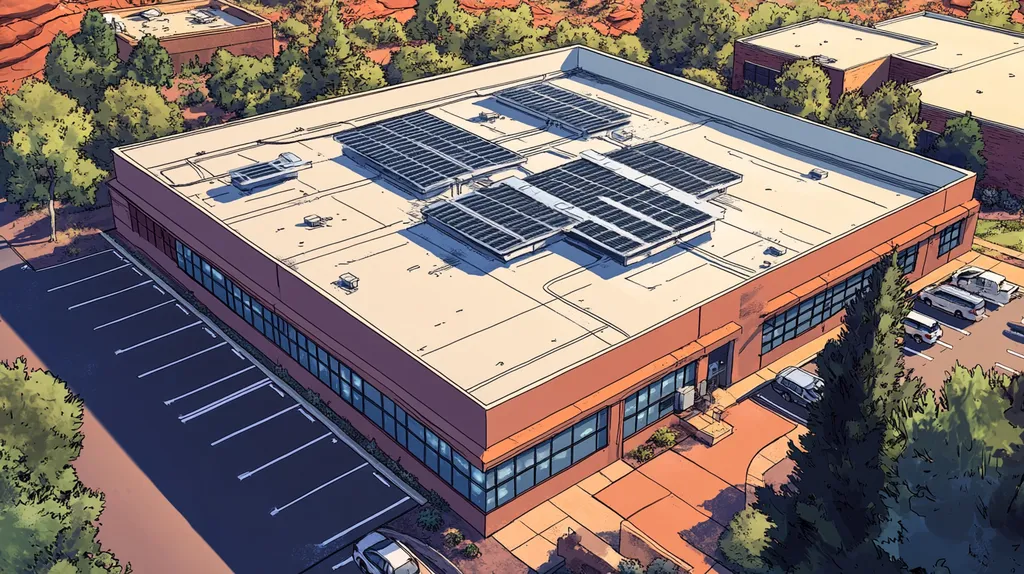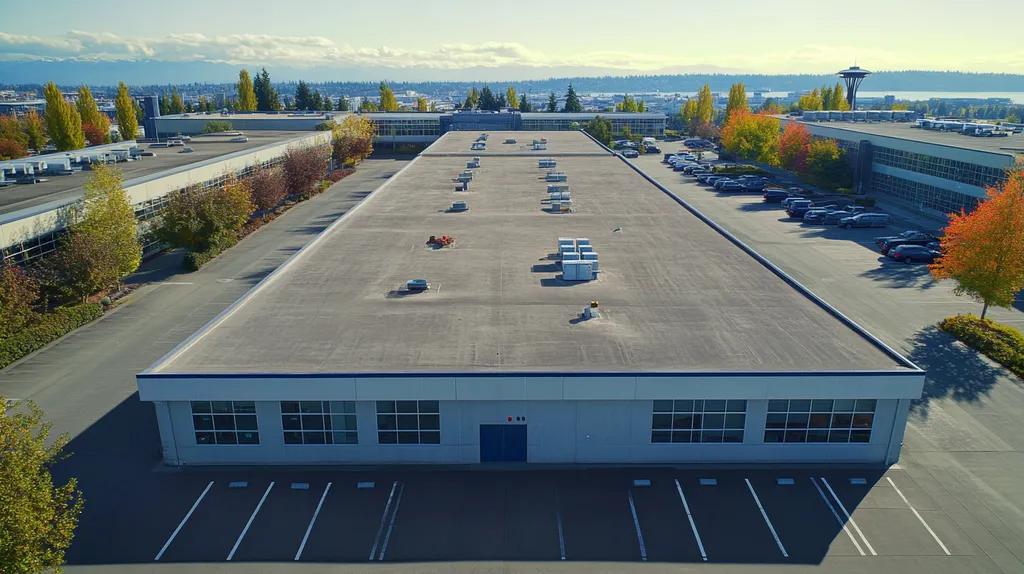Commercial property owners face mounting pressure to maximize energy efficiency as utility costs continue to climb, with buildings losing up to 40% of their heating and cooling through inadequate roofing systems.
An energy-efficient roof can reduce HVAC expenses by up to 30% while significantly boosting property values in today’s sustainability-focused real estate market.
This comprehensive guide examines the critical components, implementation strategies, and maintenance requirements that enable commercial property owners to optimize their roofing systems for maximum energy efficiency and enhanced market value.
SECTION 1: FUNDAMENTAL CONCEPTS
The need for energy-efficient commercial roofs is more pressing than ever. As energy costs climb and environmental regulations tighten, property owners must embrace roofing solutions that save money and enhance eco-friendliness. Research indicates that energy-efficient roofs can slash heating and cooling costs by as much as 30%. Such savings not only boost a property’s financial performance but also elevate its market value. In this section, we will delve into the heart of energy efficiency, examine how climate influences material choices, and outline the key principles of thermal insulation.
Energy Efficiency Basics
Understanding energy efficiency in roofing is essential for minimizing a building’s heating and cooling demands. Roofs designed with energy efficiency in mind often include reflective coatings and effective insulation to reduce heat absorption. Notably, research highlights that around 40% of a building’s energy loss escapes through the roof.
By opting for energy-efficient roofing, property owners can significantly cut their costs while supporting sustainability efforts. For instance, a reflective roof can decrease temperatures by 50 degrees or more, leading to a lower reliance on air conditioning. This not only translates to reduced utility bills but also prolongs the lifespan of HVAC systems.
Energy-efficient roofs enhance a building’s sustainability profile, attracting tenants who are committed to eco-friendly practices. Properties with ENERGY STAR ratings generally command higher rents and appeal to businesses that prioritize environmental responsibility.
Ultimately, investing in energy-efficient roofs empowers property owners to meet the needs of an eco-focused market, providing greater long-term value.
Climate and Roofing Materials
The local climate is a crucial factor in selecting the most effective roofing materials for energy efficiency. Buildings located in hot regions can benefit immensely from reflective materials, while those in colder climates need superior insulation to retain heat. Understanding these climate-driven needs is vital for making informed roofing choices.
For example, white TPO or PVC roofs can effectively reflect sunlight in warmer climates, reducing the building’s cooling load. In contrast, materials like EPDM or modified bitumen are excellent for colder regions, as they provide enhanced thermal insulation to keep heat inside during winter. Each material presents its own advantages and disadvantages, making the right selection key for maximizing energy savings.
Furthermore, local building codes often mandate specific materials that optimize energy performance. Property owners should ensure that their roofing decisions align with both climatic conditions and regulatory standards to achieve peak efficiency and compliance.
By grasping the connection between climate and roofing materials, property owners can enhance energy performance and safeguard their property’s value.
Thermal Insulation Principles
Thermal insulation plays an essential role in boosting the energy efficiency of commercial roofs. Insulation’s primary function is to slow heat transfer, ensuring buildings remain cooler in summer and warmer in winter. Effective insulation can lead to substantial reductions in energy use, positively impacting operational expenses.
Common insulation materials include fiberglass, foam boards, and spray foam, each offering different levels of thermal resistance, known as R-value. Higher R-values indicate better insulation capabilities. Choosing the right R-value tailored to the specific climate can make a significant difference in a building’s energy efficiency.
Installation practices also heavily influence insulation performance. Proper installation is crucial to avoid gaps and ensure maximum effectiveness of the insulation materials, which helps prolong the roofing system’s lifespan. Skilled professionals must adhere to industry standards during the installation process.
Investing in high-quality thermal insulation not only elevates energy efficiency but also fosters a comfortable working environment, enhancing tenant satisfaction and retention.
SECTION 2: SYSTEM COMPONENTS
The components of an energy-efficient commercial roof are vital for maximizing property value and cutting operational costs. The choices made in roofing systems directly impact energy loss and utility expenses. For example, using reflective materials can lower a building’s cooling costs by as much as 20%. In this section, we will explore the key components that make up an effective energy-efficient roof, with a focus on reflective materials, insulation types, and roof coatings.
Reflective Roofing Materials
Reflective roofing materials are essential for minimizing heat absorption, helping to keep buildings cooler during the hot summer months. Materials such as white or light-colored membranes effectively reflect sunlight, thus reducing the reliance on air conditioning. This shift not only improves comfort but also leads to substantial energy savings.
For instance, a reflective Thermoplastic Olefin (TPO) roofing system can lower temperatures on the roof by as much as 60 degrees Fahrenheit compared to conventional dark roofing options. This notable temperature decrease results in lower electricity bills, benefiting the property owner’s bottom line.
Moreover, utilizing reflective materials can prolong the lifespan of roofing systems by decreasing thermal stress. By reducing excessive heat buildup, these materials help prevent damage that can lead to expensive repairs.
Incorporating reflective roofing is more than just an energy-efficient decision; it can also enhance property value. Many prospective buyers actively seek out buildings with energy-efficient features, making these roofs an attractive selling point.
Insulation Types and R-Values
Effective insulation is a cornerstone for maintaining energy efficiency in commercial roofs. The R-value is a critical measure of insulation’s effectiveness, indicating how well it resists heat flow; the higher the R-value, the better the insulation can lower heating and cooling costs.
Several types of insulation are available, including polyisocyanurate, expanded polystyrene, and fiberglass. Among these, polyisocyanurate is often preferred for its superior R-value and moisture resistance, making it a strong contender for energy-efficient roofs.
For optimal performance, property owners should select an R-value that corresponds with their local climate. For instance, warmer regions may benefit from an R-value of around 30, while colder climates could require R-values exceeding 50.
Investing in high-quality insulation not only reduces energy costs but also increases a property’s overall appeal in the market. Buyers are increasingly drawn to buildings that prioritize energy efficiency and sustainability.
Roof Coatings and Sealants
Roof coatings and sealants are important additions that enhance both the functionality and durability of a commercial roof. These products provide an extra protective layer against the elements, helping to extend the life of the roofing system.
Elastomeric coatings, for example, can boost energy efficiency by creating a reflective surface that minimizes heat absorption. This can lead to significantly cooler indoor temperatures and reduced energy consumption.
Sealants also play a crucial role by preventing water infiltration, a major cause of long-term damage. When roofs are properly sealed, property owners can avoid the expensive repairs associated with leaks and structural issues.
Utilizing roof coatings and sealants is an investment in the long-term durability and energy efficiency of the property. This commitment to quality can enhance a building’s appeal to future buyers who are interested in energy-conscious options.
SECTION 3: IMPLEMENTATION METHODS
Implementing energy-efficient roofing systems is more than just a good idea; it’s essential for modern commercial properties facing rising energy costs. Property owners need to explore effective solutions that not only cut expenses but also align with sustainability goals. The U.S. Department of Energy notes that enhancing insulation and roofing materials can reduce heating and cooling costs by up to 30%. This section outlines the key steps for integrating energy-efficient roofing, focusing on selecting materials, optimizing insulation, and applying reflective coatings.
Selecting the Right Roofing Material
The roofing material chosen can greatly affect energy efficiency. Options like TPO (Thermoplastic Olefin) and EPDM (Ethylene Propylene Diene Monomer) membranes provide excellent insulation and durability. These materials can effectively reflect sunlight, helping to minimize heat absorption, which leads to reduced energy costs.
An innovative choice is green roofing systems, which incorporate vegetation. Not only do they enhance insulation, but they also improve air quality and manage stormwater better. Upgrading to energy-efficient materials can boost property value by improving overall performance and visual appeal.
It’s also vital to consider local climate conditions when making material choices, as some roofing materials excel in specific weather scenarios. Property owners should collaborate with roofing experts to identify the best solutions tailored to their unique geographical challenges.
Selecting the right roofing material is not merely a cost decision; it’s an investment that promises long-term savings and fosters sustainability. The proper choice can lead to efficiency upgrades that deliver substantial returns over time.
Installing Insulation and Ventilation
Proper insulation and ventilation are essential for maximizing the efficiency of any roofing system. Insulation maintains the desired indoor temperature by minimizing heat loss during winter and keeping unwanted heat out in summer. In fact, around 70% of the energy used in commercial buildings is devoted to heating and cooling; thus, enhancing insulation can translate into meaningful cost savings.
Ventilation plays an equally vital role by preventing moisture buildup, which can lead to mold growth and structural damage. Effective installation of ridge vents and soffit vents can help lower indoor temperatures, reducing the need for air conditioning.
Investing in sufficient insulation and ventilation not only leads to lower energy bills but also extends the lifespan of the roofing system, significantly enhancing the property’s overall value.
Applying Reflective Roof Coatings
Reflective roof coatings represent a forward-thinking solution to enhance energy efficiency. These coatings can lower roof surface temperatures by as much as 60 degrees Fahrenheit, significantly reducing the heat absorbed by the building. This decrease directly correlates with less air conditioning usage and lower energy bills.
Additionally, applying reflective coatings can prolong the lifespan of roofing materials by shielding them from UV damage. This protection translates to cost savings on premature replacements and supports sustainability efforts by reducing waste in landfills.
SECTION 4: MAINTENANCE REQUIREMENTS
Maintaining an energy-efficient commercial roof is not just a smart move; it’s critical for protecting the investment in a property. Neglecting roof care can lead to energy loss, expensive repairs, and a significant drop in property value. Research from the National Roofing Contractors Association shows that inadequate maintenance can cut a roof’s lifespan by up to 50%. It’s essential for property owners to prioritize annual inspections, moisture damage prevention, and timely repairs to safeguard their assets.
Annual Roof Inspections
Annual roof inspections are essential for spotting potential problems before they snowball into costly issues. During these evaluations, professionals carefully check the roof’s condition for signs of cracks, blisters, or loose seams. Early detection of minor issues can prevent them from escalating into major repairs down the line.
The inspection team also evaluates drainage systems and insulation effectiveness. Blocked drainage can cause water to pool, putting unnecessary stress on the roof and undermining its energy efficiency. A properly functioning roof minimizes heating and cooling expenses while enhancing the overall value of the property.
Keeping a record of inspection results can also boost the resale value of the property. Buyers are more likely to feel confident in their purchase when they see documented evidence of regular maintenance. This proactive stance not only protects financial resources but also adds appeal to the property.
Without routine inspections, roofs risk developing leaks or structural issues over time, which could lead to hefty maintenance bills. Therefore, establishing a schedule for annual inspections is crucial for property owners dedicated to preserving both energy efficiency and property value.
Preventing Moisture and Heat Damage
Moisture control is foundational for effective roof maintenance. Water intrusion can severely compromise insulation, leading to inefficiencies and costly repairs. Property owners should invest in proper drainage systems and regularly check to ensure they remain unobstructed.
Utilizing energy-efficient roofing materials also helps regulate roof temperature, reducing the likelihood of heat damage. Options like roof coatings, reflective membranes, or even green roofs can bolster energy efficiency and minimize issues related to thermal expansion, extending the roof’s life and saving replacement costs.
Regular inspection of sealants and flashing is vital for preventing moisture accumulation. If seams are compromised, water can penetrate and weaken the roofing system. Addressing these issues promptly empowers property managers to protect their investments and reduce long-term operational expenses.
Incorporating moisture monitoring technology can further enhance preventive efforts. These systems provide real-time alerts, enabling property managers to tackle issues proactively. Vigilance in managing moisture is crucial for maintaining energy efficiency and upholding property value.
Repairing and Replacing Components
Timely repairs are crucial for preserving the energy efficiency of a commercial roof. When components such as membranes or insulation show signs of wear, acting quickly is essential. Delaying repairs can lead to energy loss, which translates to higher utility bills for property owners.
Evaluating whether repairs or full replacements are more cost-effective is also critical. In some instances, replacing an aging roof with a new, energy-efficient system might offer greater long-term savings. Modern roofing materials typically provide enhanced insulation properties, further improving energy efficiency.
Repair work should be conducted by qualified professionals familiar with commercial roofing systems. Correct installation of new materials or reinforcement of existing ones is vital for ensuring longevity and efficiency. Property owners should expect a warranty on repairs to add an extra layer of financial security.
Having a planned maintenance program that includes regular reviews of roof components can help mitigate unexpected expenses. This foresight supports energy efficiency and maximizes market value for the building. Recognizing when to repair and when to replace is essential for maintaining a property’s worth.
SECTION 5: PERFORMANCE METRICS
Performance metrics are essential for property owners to grasp how energy-efficient roofs contribute to savings and overall value. With energy prices continuing to rise, the pressure is on to select roofing solutions that not only lower costs but also improve building performance. For instance, studies show that facilities equipped with energy-efficient roofs can experience reductions in cooling costs by up to 30%. This section focuses on three critical performance metrics: measuring energy savings, assessing roof lifespan extension, and evaluating indoor comfort levels.
Measuring Energy Savings
Measuring energy savings from a commercial roof is crucial for understanding the financial benefits for a facility. Energy-efficient roofs, often made with reflective materials, minimize heat absorption and lower air conditioning needs. For example, buildings with cool roofing systems can substantially cut their energy bills, generating significant annual savings.
Tracking energy consumption before and after installing an energy-efficient roof is vital. By using energy management software, facility managers can compare historical utility bills with updated data to see clear savings in real terms. Additionally, such roofs may qualify for rebates or incentives from utility providers, further enhancing savings.
Beyond immediate savings, energy-efficient roofs can boost a building’s energy rating. A stronger energy profile makes properties more appealing to prospective tenants or buyers, ultimately increasing market value. Therefore, assessing energy savings fosters both short-term financial benefits and long-term value enhancement.
To maintain continued performance, regular monitoring and scheduled maintenance should be implemented. By keeping thorough records of energy usage and roof performance, property owners can sustain their savings and swiftly address potential issues, ensuring that energy efficiency remains optimal.
Assessing Roof Lifespan Extension
Understanding how energy-efficient roofing can extend the lifespan of the roof is vital for future financial planning. Traditional roofs often need replacement every 15-20 years, while energy-efficient materials, such as thermoplastic polyolefin (TPO) or modified bitumen, can last up to 30 years with proper care. This durability is largely thanks to their ability to reflect harmful UV rays and effectively manage water runoff.
Conducting regular inspections and maintenance is key to preventing issues that could reduce a roof’s lifespan. Roofs with enhanced reflective properties are less prone to damage from thermal expansion, further maximizing longevity. This proactive approach not only preserves the roof’s integrity but also sustains its energy efficiency over time.
Moreover, warranties from manufacturers for energy-efficient materials often surpass those for traditional options, providing additional reassurance for property owners. These extended warranties, combined with documented savings and improved performance, can significantly elevate a property’s market value, underlining the wisdom of investing in energy-efficient systems.
Ultimately, an extended roof lifespan means reduced capital expenditure on repairs and replacements, allowing property managers to direct resources toward other essential upgrades or operational needs. This investment aligns seamlessly with both immediate and long-term strategic goals.
Evaluating Indoor Comfort Levels
Evaluating indoor comfort levels is critical for assessing the full benefits of energy-efficient roofs. Building occupants frequently report higher satisfaction in environments where stable temperatures are maintained, which can lead to increased productivity. This improvement is largely attributable to enhanced insulation and humidity control provided by energy-efficient roofing materials.
Furthermore, energy-efficient roofs often play a role in reducing interior noise levels, a benefit that isn’t always recognized. Reflective surfaces help to control heat penetration and improve thermal dynamics, contributing to a more pleasant atmosphere inside. Elevated comfort levels also significantly contribute to tenant retention, an essential factor for thriving commercial properties.
Installing energy-efficient roofs can positively affect air quality by reducing humidity and condensation build-up within the roofing system. Improved ventilation not only enhances comfort but also helps prevent mold and mildew, fostering a healthier indoor environment.
Property managers who focus on indoor comfort through energy-efficient roofing will find that occupant well-being is improved, which can lead to higher property valuations. Investing in tenant comfort ultimately creates a win-win scenario, boosting satisfaction while enhancing the market appeal of the property.
SECTION 5: PERFORMANCE METRICS
Performance metrics are essential for property owners to fully understand how energy-efficient roofs create savings and enhance overall value. With rising energy costs, the pressure is on to choose roofing solutions that not only mitigate expenses but also improve building efficiency. For instance, recent studies reveal that commercial properties equipped with energy-efficient roofs can potentially reduce cooling costs by as much as 30%. In this section, we will explore three critical performance metrics: measuring energy savings, assessing roof lifespan extension, and evaluating indoor comfort levels.
Measuring Energy Savings
Measuring energy savings from a commercial roof involves meticulous calculations that can significantly influence a facility’s financial health. Energy-efficient roofs, typically featuring reflective materials, effectively minimize heat absorption and thus lower air conditioning needs. For example, buildings equipped with cool roofing systems can see appreciable reductions in energy expenses, resulting in impressive annual savings.
To quantify these benefits, it’s crucial to monitor energy consumption both before and after installing an energy-efficient roof. By utilizing energy management software, facility managers can compare historical utility bills against updated figures, clearly illustrating the financial gains. Additionally, many energy-efficient roofs are eligible for rebates or incentives from utility providers, which can further enhance the overall savings.
Beyond immediate savings, these roofs can elevate a building’s energy rating. A stronger energy profile not only attracts potential tenants but also boosts property value. Thus, measuring energy savings supports both short-term financial benefits and long-term value appreciation.
To maintain this performance, ongoing monitoring and scheduled maintenance are key. Regularly documenting energy usage and roof efficiency will help property owners ensure sustained savings and quickly address any emerging issues, keeping energy efficiency at peak levels.
Assessing Roof Lifespan Extension
Understanding how energy-efficient roofing can extend a roof’s lifespan is crucial for long-term investment planning. Traditional roofs often require replacement every 15-20 years; however, energy-efficient materials, such as thermoplastic polyolefin (TPO) or modified bitumen, can last up to 30 years when properly maintained. This increased longevity results from their ability to deflect harmful UV rays and efficiently shed water.
Routine inspections and maintenance are vital for identifying potential problems that could shorten a roof’s lifespan. Roofs with reflective properties tend to be more resilient to thermal expansion damage, ensuring greater durability. Consequently, proactive maintenance strategies will optimize the longevity and efficiency of energy-efficient roofs.
Furthermore, manufacturers typically offer warranties for energy-efficient materials that exceed those for traditional options, providing added peace of mind for property owners. These extended warranties, combined with documented savings and improved performance, can significantly boost a property’s market value, reinforcing the wisdom of investing in energy-efficient systems.
In the end, an extended roof lifespan translates to fewer capital expenses on repairs and replacements, allowing facility managers to allocate resources to other important upgrades or operational needs. This investment in energy-efficient roofing aligns seamlessly with both immediate business requirements and long-term strategic goals.
Evaluating Indoor Comfort Levels
Assessing indoor comfort levels is crucial for realizing the comprehensive benefits of energy-efficient roofs. Building occupants often report greater satisfaction when temperatures are stable, which often leads to heightened productivity. This enhancement can largely be attributed to improved insulation and humidity control facilitated by energy-efficient roofing materials.
Moreover, energy-efficient roofs help reduce interior noise levels—an often-underappreciated benefit. Reflective surfaces not only mitigate heat penetration but also improve thermal dynamics, leading to a more comfortable indoor environment. When comfort levels are raised, tenant retention often improves, a critical factor for the success of commercial properties.
These roofs also contribute to better air quality by minimizing humidity and condensation buildup within the roofing system. Enhanced ventilation not only boosts comfort but also reduces the risk of mold and mildew, fostering a healthier indoor atmosphere.
Property managers who prioritize indoor comfort through energy-efficient roofing will likely find an increase in occupant well-being, which can enhance property valuation. Investing in tenant comfort ultimately creates a win-win scenario, boosting satisfaction while also elevating the property’s market appeal.
Looking Ahead
With energy costs projected to rise 30% over the next decade, property owners who fail to implement energy-efficient roofing systems risk significant financial exposure and declining property values.
The data clearly shows that energy-efficient commercial roofs deliver measurable returns through reduced HVAC costs, extended roof lifespans, and enhanced property values – often paying for themselves within 5-7 years.
As sustainability becomes increasingly critical to tenants and buyers, buildings with optimized roofing systems will command premium prices and stronger occupancy rates.
Property owners who act now to upgrade their roofing infrastructure position themselves to capitalize on this market shift while protecting their assets against rising operational costs.
The future of commercial real estate belongs to energy-efficient buildings – and it starts at the roof.
FREQUENTLY ASKED QUESTIONS
Q. Why are energy-efficient commercial roofs important?
A. Energy-efficient roofs significantly cut heating and cooling costs, improving profit margins. These roofs also align with environmental regulations and attract eco-conscious tenants, enhancing your property’s market value.
Q. What types of commercial roof materials are the most efficient?
A. Materials like reflective TPO and PVC are effective for reducing heat absorption. Choosing the correct material based on your climate conditions is key to optimizing energy efficiency and prolonging roof life.
Q. How do I properly maintain my industrial roof?
A. Regular inspections, timely repairs, and monitoring for moisture are crucial. This proactive approach helps prevent significant damage and maintains the roof’s energy efficiency and property value.
Q. What factors improve a commercial roof’s energy efficiency?
A. Using materials with high R-values, incorporating reflective coatings, and ensuring proper insulation all enhance energy efficiency. Climate-specific choices are vital for maximizing the roof’s performance and comfort levels indoors.
Q. How can I measure the savings from an energy-efficient roof?
A. Track energy consumption before and after installation with energy management software. This comparison will help identify savings and reinforce the financial benefits of your roofing investment.
Q. What impact does insulation have on my commercial roof?
A. Insulation slows down heat transfer, maintaining stable indoor temperatures. Proper insulation leads to significant energy savings while improving comfort for tenants and contributing to higher property values.
Q. Are there incentives for implementing energy-efficient roofing?
A. Yes, many regions offer rebates or incentives for adopting energy-efficient upgrades. These financial incentives can offset initial installation costs and enhance your overall return on investment.

